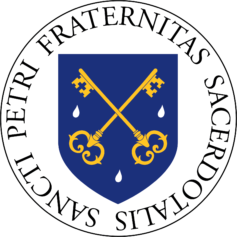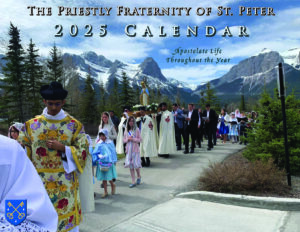The Liturgical Sources of Carroll’s Prayer for the USA
Given Fr. Stinson’s initiative of prayer for October, it is a perfect time for a more in-depth examination of Archbishop Carroll’s “Prayer for the Church and the Civil Authorities“.
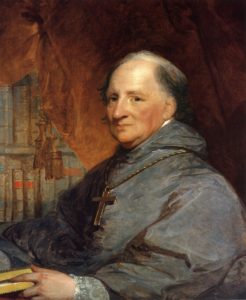
This prayer has been a part of American Catholicism almost since the Republic’s founding–indeed, it could rightly be said that it is the American Catholic devotion par excellence, given its long history and its prominent presence in myriad devotional manuals and Missals, notably including the Baltimore Manual of Prayer (1888), the New Roman Missal of Fr. Lasance (1945).
Structurally, Carroll’s prayer consists of a series of orations imploring God’s assistance on behalf of:
* the catholicity and preservation of the Church
* the ecclesial hierarchy
* the Federal government
* the state government and judiciary
* the citizens of the United States
* the faithful departed
Conceptually these seem to draw from the Intercessions in the Good Friday Mass of the Presanctified, which has a similar progression of prayers for the Church, the Pope, the clergy, the Faithful, and for rulers, etc. In fact, the opening of Carroll’s prayer is a direct translation from the first collect of the Good Friday liturgy:
We pray Thee, O Almighty and Eternal God, who through Jesus Christ hast revealed Thy glory to all nations, to preserve the works of Thy mercy; that Thy Church, being spread through the whole world, may continue, with unchanging faith, in the confession of Thy name.
Omnipotens sempiterne Deus, qui gloriam tuam omnibus in Christo gentibus revelasti: custodi opera misericoriæ tuæ; ut Ecclesia tua, toto orbe diffusa, stabili fide in confessione tui nominis perseverat.
Following this are similarly-constructed but apparently new prayers, specifically tailored to the government established by the 1787 Constitution. The offices of President and Congress, Governors, and the judiciary are directly referenced. Carroll may have composed these petitions himself, perhaps influenced by a vaguely similar prayer published in 1789 by the Abbe Claude de la Poterie and recited each Sunday at the Church of the Holy Cross in Boston.
The final paragraph, however, is again directly liturgical. Much of its language is taken verbatim from the Commemoration of the Dead in the Roman Canon (Memento etiam):
“Finally, we pray Thee, O Lord of mercy, to remember (Memento) the souls of Thy servants (famulorum famularumque) departed who are gone before us with the sign of faith, and repose in the sleep of peace (qui nos praecesserunt cum signo fidei, et dormiunt in somno pacis).”
Carroll’s prayer then names various categories of the departed: parents, relations, and friends, etc. that are not specifically mentioned in the Mass. It concludes, however, with an almost exact quote from the Canon, the only difference being Carroll’s insertion of the word “everlasting.”
“To these, O Lord, and to all that rest in Christ, grant, we beseech Thee, a place of refreshment, light, and everlasting peace.”
Ipsis, Domine, et omnibus in Christo quiescentibus, locum refrigerii, lucis et pacis, ut indulgeas, deprecamur.
Overall, while this composition shows much that has been newly tailored to the new government and the new situation of the Catholics in the United States, it also kept one foot firmly in tradition by modeling itself on immemorial liturgical prayer and by directly translating passages from the Roman Canon and the Solemn Intercessions of Good Friday.
And as this important part of the American Catholic patrimony has seen action in some of the nation’s most critical hours, including the Civil War, it seems only right to keep it close at hand in our own.
October 5, 2020

On the Motives of the North American Martyrs: Part 3
Concluded from Part 1 and Part 2.
Many think we enjoy a culture of freedom.
But amidst enslavement resulting from our gross economic irresponsibility, we are killing ourselves through contraception and abortion at a rate alarmingly greater than any Iroquois tomahawk could have ever achieved. This is the reality the Catholic is confronted with today, and so we must beware of just going with the flow and burying our heads in the sand.
Granted, there is little we can do to stop certain things, but we can educate ourselves and evaluate how much we permit ourselves to be influenced by the culture we live in.
The Catholic is the sign of contradiction.
This does not mean we stand in opposition to everything, but rather that everything we do we strive to put under the influence of Christ. That is the mission spirit of Christ which compelled the Apostles to go and teach, a mission which must always begin with example, based upon that same grace-driven conviction that inspired the martyrs and all the saints to do it before us.
We all play a part in this – large or small, it does not matter – because each of us constitutes a cell of Christ’s Mystical Body. We all must daily be willing to die to self, to embrace the Cross, and love Christ no matter what, refusing to make the world’s maxims of happiness our own.
How do we read the trials of the martyrs? Are we inspired to be less motivated by convenience, comfort, or human respect? Although we will likely be spared the physical tortures they had to endure, the mental tortures do run a close second, so let us not forget how our efforts are supposed to seed the world for the blossoms of new faith.
God is permitting the fields to be burned, and they stand in need of re-seeding.
Even though we are not in mortal danger at the present moment, let the martyrs’ examples inspire us to make most important what is most important: Sunday Mass and Holy Communion – that contact with Christ through the Mass – should hold the greatest importance in our lives. As the world tries to kick us down, let us be inspired by the heroes the Church gives us to lift us up, so that we are convinced of the power behind the Church’s mission.
Perhaps we will find inspiration to make an extra Mass during the week if possible, even if a little inconvenient, or to get to confession more regularly, or immediately if the case calls for it.
Maybe their example will inspire us come to terms with some suffering we have to endure, or – better yet – need to embrace; maybe it will make us think twice about the movies we watch, or music we listen to, or the websites we view or the clothes we wear; maybe their example will inspire fathers to lead their families in prayer, to abandon occasions of sin, and take their role as spiritual head seriously; to inspire mothers to realize that the chapped hands of their labors proves that the stigmata is not reserved only to mystics.
Should not the trials of the martyrs, in their efforts to spread the love of our Lord, inspire reconciliation between spouses and renewed commitment under difficulties?
Remember, our faith is seeded by those who have gone and suffered before us. Let us make a return for what we have been given by praying regularly, by uniting our sufferings with the Cross, by doing that family Rosary at least once a week, by making the First Fridays, and by doing everything we can to keep ourselves in a state of grace and increase it through works of charity.
One theme that runs through the lives of all the saints and martyrs is consistency and resignation to the trials God’s Providence permits so as to gain profit for eternity, and so we must pray for the same spirit of the missionary-martyrs if we want to reap the same kinds of fruits, whatever our trials may be – and we should want to, because it could mean all the difference between a life without Jesus Christ and a life with Him.
Ever think why the hearts of those two disciples burned as they walked unknowingly with Christ on the road to Emmaus, as He expounded the divine truths about our Redemption?
It was because that was what they were thirsting for. Our own thirst for Christ will make others thirsty, and so we should all seek and cultivate that same desire, especially when the chips seem down – ask for it, pray for it.
For that is what mattered most to these saints and enabled them to endure the pains they did, a veritable labor of love for fruit they would never see in this life, a labor that magnified Christ in their bodies, so as to forfeit their lives on the battlefield of salvation for the love of Christ, only to gain Him forever after death and possess that true joy no one can ever take away.
October 2, 2020

Prayer for the Church and Civil Authorities
In this time of trial for the Church and the nation, and amidst continued restrictions on the sacraments and churches, North American District Superior Fr. Michael Stinson, FSSP has asked friends of the Fraternity to recite the Prayer for the Church and the Civil Authorities daily during October 2020, invoking God’s intervention on behalf of our ecclesiastical and civil leaders.
Prayer for the Church and the Civil Authorities
Archbishop John Carroll, A.D. 1800
We pray Thee, O Almighty and Eternal God, who through Jesus Christ hast revealed Thy glory to all nations, to preserve the works of Thy mercy; that Thy Church, being spread through the whole world, may continue, with unchanging faith, in the confession of Thy name.
We pray Thee, who alone art good and holy, to endow with heavenly knowledge, sincere zeal, and sanctity of life our chief bishop, Francis, the Vicar of our Lord Jesus Christ in the government of His Church; our own Bishop, (or Archbishop,) N., (if he is not consecrated, our Bishop-elect); all other Bishops, Prelates, and Pastors of the Church ; and especially those who are appointed to exercise among us the functions of the holy ministry, and conduct Thy people into the ways of salvation.
We pray Thee, O God of might, wisdom, and justice, through whom authority is rightly administered, laws are enacted, and judgments decreed, assist, with Thy Holy Spirit of counsel and fortitude, the President of these United States, that his administration may be conducted in righteousness, and be eminently useful to Thy people, over whom he presides, by encouraging due respect for virtue and religion; by a faithful execution of the laws in justice and mercy; and by restraining vice and immorality. Let the light of Thy divine wisdom direct the deliberations of Congress, and shine forth in all the proceedings and laws framed for our role and government; so, that they may tend to the preservation of peace, the promotion of national happiness, the increase of industry, sobriety, and useful knowledge, and may perpetuate to us the blessings of equal liberty.
We pray for his Excellency the Governor of this State, for the members of the Assembly, for all Judges, Magistrates, and other officers who are appointed to guard our political welfare; that they may be enabled, by Thy powerful protection, to discharge the duties of their respective stations with honesty and ability.
We recommend likewise to Thy unbounded mercy all our brethren and fellow-citizens, throughout the United States, that they may be blessed in the knowledge, and sanctified in the observance of most holy law; that they may be preserved in union, and in that peace which the world cannot give; and, after enjoying the blessings of this life, be admitted to those which are eternal.
Finally, we pray Thee, O Lord of mercy, to remember the souls of Thy servants departed who are gone before us with the sign of faith, and repose in the sleep of peace: the souls of our parents, relations, and friends; of those who, when living, were members of this congregation; and particularly of such as are lately deceased; of all benefactors who, by their donations or legacies to this Church, witnessed their zeal for the decency of divine worship, and proved their claim to our grateful and charitable remembrance. To these, O Lord, and to all that rest in Christ, grant, we beseech Thee, a place of refreshment, light, and everlasting peace, through the same Jesus Christ, our Lord and Savior. Amen.
As October is dedicated to the Blessed Mother, readers are also urged to unite their rosaries under her title of Our Lady of Victory.
September 29, 2020

On the Motives of the North American Martyrs: Part 2
As we know, the phrase Church militant is not very popular nowadays, possibly because the sound of it seems so opposed to the modern conception of love and peace and nicety which, for the most part, is romanticized and sentimental.
Catholicism, at its core, is anything but romanticized and sentimental.
Since it originates in Christ, our holy Faith when lived has the same effect as the Incarnation: penetrating, invigorating, convicting, transforming, certain, secure, filling one with hope and zeal, especially because it creates a perspective on suffering that gives real meaning to it. Of course, being sympathetic and compassionate to the sufferings of another, no matter who they are – which we all must be in imitation of Christ – hardly means sacrificing one ounce of the integrity of the Faith or our conviction of truth. And this is how our lives are to be seen as forfeit for the sake of Christ.
Do we not find this to be, then, the motive of the martyrs that blanket the history of the Church?
When reading the history of the missionary efforts of the North American Martyrs, our modern “tolerant” and politically correct world has no choice but to hold their labor in disdain, calling it insensitive, perhaps imperialistic, an unwelcome and unnecessary intrusion upon autonomous and “peaceful” cultures that were best left to themselves (regardless if, in reality, they were locked in brutal war with one another).
If the injustices committed during colonization are cited as support for this argument, and there were many, we need to remember that those injustices were at the hands of corrupt individuals or governments seeking to exploit the natives for monetary gain. That is not the spirit of Christ, and the missionary efforts had nothing to do with that; in fact, throughout history we see the missionaries condemning such things.
Quite to the contrary, St. Isaac Jogues and his companions looked upon the natives, not in some economic and utilitarian way, but as souls Christ had redeemed by His Blood who, since they did not know that, were considered as the poorest of the poor.
When was the last time we heard of the poor described as that, of those ignorant of the Faith rather than being monetarily and materially needy? To these missionaries, the natives were truly victims of darkness and idolatry and stood in need of the real freedom only the Holy Faith could give, a depraved nation on account of never hearing the name of Jesus Christ, true God and true Man, ignorant of the perfections and wonders of His life, the power of His Cross, and the effects of His Sacraments.
This is why they sought to evangelize them.
Think about all that we as Catholics take for granted: Baptism, the Holy Mass, the Holy Eucharist, the parables of our Lord that we hold so dear and that give us faith and hope, the Our Father, the Blessed Mother, the Rosary, the security of the Church’s maternal authority under the Pope and Magisterium – all these things and much more did the missionaries regard as far more important than their own lives so as to impart them to ignorant peoples for the salvation of their souls, empowering them with the responsibility and freedom to love Christ, taking Christ’s command to heart to go and teach and baptize.
And it is this flame of holy charity that compelled them to repeatedly undergo unspeakable tortures to plant the seeds for the eventual conversion of all the tribes to the true Faith of Jesus Christ and to His Holy Catholic Church, to turn them away from darkness and frustrate the advance of Satan’s kingdom.
When we read the epic accounts of the North American martyrs, perhaps we stand in disbelief over what our Lord asked these men to endure for His sake in order to secure the Kingdom for themselves and for others.
In fact, these missionary-martyrs would see little visible profit from their efforts (their journals even make mention of discouragement over the seemingly low conversion rate, although trying to temper that with a willingness to suffer for Christ).
We are the ones who get to enjoy the fruit reaped from the seeds of their humble and inspiring sacrifices, a bounty in which we are included. Therefore, the true apostle cannot stand to have things just live and let live if, in so doing, ignorance of Christ triumphs. Granted, sometimes we cannot say anything to change a situation, but we can endure patiently and use that time to strengthen hope in Christ’s victory.
For these martyrs, it was the conviction of their faith, a conviction which the world calls intolerant but from which the believer draws inspiration, that drove them literally into the wilderness to follow Christ’s call.
Is the call then any less for the Catholic today?
Perhaps it is even more imperative. We live in moral wilderness. Is the world really anything different than the savage conditions the martyrs labored under? Don’t let the iPods and computers and technology fool you: they amount more or less to a smoke-screen of sophistication that hides a prevailing blindness in regard to eternal truths and realities.
Ironically, in this age of information, the one thing that ought to be known goes ignored, and so the modern world is no less a victim of the idolatry of selfishness, greed and lust. Even more depraved, in fact, from once upon a time having heard the name of Jesus Christ and then rejecting it: He came unto His own, and His own received Him not.
To be continued….
September 28, 2020

On the Motives of the North American Martyrs: Part 1
Christ shall be magnified in my body, whether it be by life or by death. For to me, to live is Christ and to die is to gain. (Phil. 1:20-21)
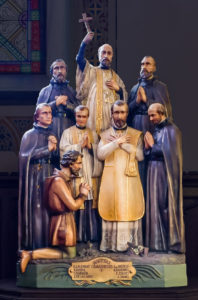
No doubt St. Paul, the great Apostle to the Gentiles, was an inspiration for the eight Jesuits known today as the North American Martyrs: SS. Anthony Daniel, Charles Garnier, Noel Chabenel, Isaac Jogues, John Lalande, John de Brebeuf, Gabriel Lalemant, and Rene Goupil.
These men all took the spirit of the Apostles with them to the natives of North America, in the modern-day regions of Ontario and upstate New York. And they would welcome and meet the same fate as Christ’s own.
It is this authentic apostolic spirit that has lived on in the Church – in spite of staggering odds – and has fueled every genuine missionary effort since Pentecost, a spirit that produces a zeal to make Christ known and loved, to spread His Gospel and His holy Catholic Church, and to suffer what God ordains in order to secure that.
At its core, the Apostolic spirit is the spirit of a soldier.
Whenever we read heroic accounts of soldiers on a battlefield, we need to remember that, in order for them to perform such acts of valor, they needed to be in a certain frame of mind: they had to be convinced that what they were fighting for was worth dying for, and they had to see the good of their fellow men as more important than their own safety.
For this reason, the moment a solider sets his foot on a battlefield, he has to consider his own life as forfeit; this is partly because he needs to psychologically deal with the reality of being in mortal danger all the time, and partly to inspire sentiments of valor.
This is really no different for the Catholic, especially as we all feel the pressure mounting from a secularist movement that is now brazenly enboldened in attempts to rid society of any trace of God. Pope Leo XIII wrote over a century ago that “Catholics are born for combat,” and a serious approach to the spiritual life, God’s commandments, and Church teaching will reveal how true that is.
We have the world, the flesh, and the devil to contend with, and the fight is not pretty at times.
If we are confirmed, it means that we must look at ourselves as soldiers called to forfeit one life for a greater life: it is the call to crucify the old Adam in us and, through humility and cooperation with grace, to put on the new One, Christ. That is the reality of the Cross and the transformation Christ wishes to work in us.
This is quite invasive, because love, if it is to have a lasting effect, is invasive: God started it all by “invading” humanity through the Incarnation. And if a Man walked the earth and claimed to be God and proved His claim, we have an obligation to respond to His commands: this response calls for an ever-increasing loyalty, a commitment that puts the hand to the ploughshare without looking back.
So since this life of ours is one of spiritual combat, the greatest lie that exists today is that there is no battle to be fought, that the battle between virtue and sin is merely a matter of opinion, that the battle between good and evil is merely a matter of perspective, and that the battle between right and wrong is merely a matter of custom.
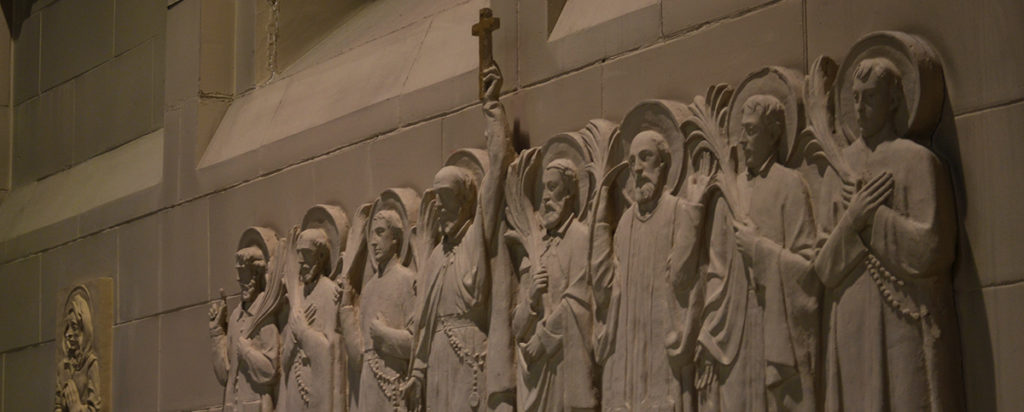
Our modern world has worked hard to replace true virtue with sentimentality and some false notion of “tolerance” that really amounts to relativism, void of any internal conviction based upon love of God and the Cross of Christ.
Does not the blatant contempt shown towards Christianity support the reality of this condition?
There is a real battle to be fought, because the only true peace that comes in this life is the peace God grants when we endeavor to live how He wants us to.
That is: to be members of His Church, to use the Sacraments, to do good and avoid evil, to embrace the difficult things for His sake, to utilize our state in life for His glory, no longer counting what it may cost to be a devout follower of Christ, and, if we fall into sin, to get out of it quickly through confession.
In essence, to live as one who knows and loves Christ crucified, to let His words influence every part of our lives, thereby making eternity the most important thing.
To be continued….
September 25, 2020

All the Way to the End
Upon hearing the news of Justice Ruth Bader Ginsburg’s passing last Friday night, in all charity a thoughtful Catholic should have offered some prayer for the repose of her soul. Priests hopefully would have included her in the Memento of the Dead at Mass in the days following. And we would hope that her soul is being prayed for as Rosary beads are thumbed by tens of thousands of Catholics across the country, all the while invoking the Mother of God to see that a new Justice is nominated and approved who will be the almost complete antithesis of Ginsburg. Not like we should put our hope in politics, as government and governors cannot save us from our sins nor from death. But we rightfully should have legitimate love of our country during our lives, always wanting to see it turn from evil and misguided ways and promote a citizenry that is virtuous.
Nonetheless, we do not get off this world alive, and the death of this prominent and influential Justice should give us pause about that very reality. Her decisions have impacted millions upon millions of lives, born and unborn, of which she had to make an account before God. This is quite daunting to think about. The secular press will laud her efforts as “pioneering” in the cause of equal rights, but it is overall clear and alarming where her priorities were, and we should rightfully have concern about her eternal fate.
Justice Ginsburg considered unrestricted abortion and access to it as a “right” for all women, and so a worldview like that will define how other issues are approached. Poisoning the river at its source adversely affects what happens downstream. This is something that cannot be ignored or escaped from, regardless of whether she may have decided favorably at times on less weighty matters. If a jewel thief happens to save an old woman crossing the street from getting hit by a car, that does not exonerate him; he still needs to stop his thievery and make amends.
So while overcoming human challenges over the course of decades to become the second woman to sit on the Supreme Court, there was no questioning her determination to implement an agenda that stood fundamentally in opposition to the most basic right every human being has. The fact that Planned Parenthood mourns the loss of a heroine in their eyes speaks volumes. The secularists stand ready to canonize another “saint” of their making, evident from the hysteria we are witnessing in some sectors over her “untimely” passing. In spite of Jewish roots, Justice Ginsburg seemed to show little care of what the God of Abraham thought about life, the natural law, and eternity, and voted as such in the key Supreme Court decisions during her tenure.
So it is on an occasion like this where thoughtful Catholics may find right reason and supernatural hope in conflict. After all, how are we to reconcile the thought of someone so committed to such a secular anti-life, anti-God platform as being admitted into a Vision where everything there is the very opposite of what she advocated during this life?
If there is even a modicum of accuracy that her dying wish was that President Trump not be the man who proposes her successor, it seems this life is all she had to hold on to. How ironic and disturbing is a life hailed as “progressive” and “forward thinking” by her champions now forced to retreat back upon itself, isolated in the face of eternity.
But while nations pass away, the Word of God does not, and no one can resist that. Indeed the will of God is our sanctification, He does will for us to be with Him in heaven for eternity, but that comes on the condition that we want to go there: If you love Me, keep My commandments. (Jn. 14:15) Our Lord forces no one to accept His love, but the rejection of it will have its consequences. In fact, He further warns that a person can become so blinded to the true good on account of obstinacy in evil that he comes to think that killing the good is actually a service to God. (Jn. 16:2)
However, it is Catholic teaching that, while we can definitely know who is in heaven, we cannot know with certainty (outside of a private revelation) if someone is damned. The pains of hell described by Our Lord in the Gospel suggest hell is far from empty; various visions of hell given to the saints through the course of two thousand years indicates that it is quite crowded. It would be misplaced optimism and foolish to think otherwise.
That said, there is wisdom in the Church’s teaching that we cannot know with certainty if a specific soul is in hell. One reason is because it keeps us from giving up on someone. We must remember that hell is so bad that we should never wish a soul to be there, even when the evidence looks bleak for someone this side of eternity. To do so would be a grave offense against charity towards our neighbor. Another reason is that it helps us remember that the price of an individual soul – beginning with our own – is our Lord’s Blood, and that should humble us at the thought that we, too, will all meet the same God for our exit interviews from this life, and to consider how well we have heeded His words. Furthermore, it leaves the individual judgment of a soul where it must be left – between the soul and the God who alone knows and reads the heart, and who accounts for each and every grace given, accepted, and rejected through life, usually unknown to the seeing public.
But Justice Ginsburg was given at least one grace in full view, and it is something even the secular media has found quite intriguing: her close friendship with the late Justice Antonin Scalia, a devout and principled Catholic whose voting record on the key issues reflected the God He loved and the Faith he internalized. The two could not have been more opposite in terms of world view; undoubtedly they locked horns often – and on the most fundamental things – but their passion for law and other mutual interests outside the Court served to unite them. She admitted that he was formidable in his challenges to her; his masterfully written dissents and arguments would merit thoughtful consideration, and she valued that. This intrigues the media, and should actually intrigue us, because there is something quite noble about it: in these days of such polarization that people who disagree cannot sit around a table, let alone be friends, here are two who could, and did. Given the man Justice Scalia was, we can likely surmise the type of friend he was as well. Only God knows how many Rosaries he prayed and how many Masses he offered for his dear friend Ruth, that she come to know and love the divine Judge who was the inspiration and model of his own career as a judge, and who ought to become the one for hers.
And he would not have given up in spite of the human odds, because that is how Catholics are called to love. As some saint writes somewhere: To love another in the highest sense of the word is to wish that person eternal possession of God and to lead him to it. True, although Justice Scalia would lead, the decision to follow would be hers. But in their friendship, he endeavored to be the presence of Christ in her life, the herald of a Kingdom, a bearer of Good News, the deliverer of an invitation to a heavenly wedding banquet offered to anyone, if only she be willing to put on the required wedding garment of faith and charity.
So as we can reasonably and legitimately have concern about where Justice Ginsburg may now be, the example of Justice Scalia should temper some of that. None of us want to be given up on, and so perhaps we can find a reason, on account of the prayers of her true friend, that Justice Ginsburg may have met a Mother at her judgement who was able to tip the scale of justice?
There is certainly no loss in a heartfelt prayer for that.
September 24, 2020

OLGS Seminarians singing “O Crux” by Brumel
We are pleased to pass along this wonderful video of Our Lady of Guadalupe seminarians singing “O Crux, Ave, Spes Unica” by Antoine Brumel, with text coming from the sixth verse of the Vespers hymn Vexilla Regis.
O Crux, Ave, Spes, Unica
Hoc passionis tempore,
Auge piis justiam Reisque dona
(veni) veniam
“O Cross, Hail, our only hope in this Passiontide, grant increase of justice and grant pardon to the guilty.”
OLGS director Nicholas Lemme and the seminarians will be performing the piece as part of a larger concert program in Lincoln, Nebraska tomorrow (Sept. 24).
September 23, 2020

Freedom From Thought continued
There is a great deal of difference between freedom of thought and freedom from thought.
Before we went to school, we were free to think that a yard was 28 inches. But once we were taught that it was actually 36 inches, we had to change our original supposition to the correct one.
By doing so, we were then able to build upon that idea. With correct measurements, we were now free to calculate the length of a football field accurately and safely, and participate in a common shared reality.

That is freedom of thought because it empowers us to use our reason correctly.
Freedom from thought would be holding on to an error after being taught that such is not the case.
One would still be free (in a sense) to construct a whole world around an erroneous measurement, but it would not be the world of reality or truth.
And any attempt to impose that world of unreality and untruth on others would, actually, be a form of violence, as it is a threat to true freedom.
Isn’t it interesting, that when the thought police and their fellow inmates try to take over the asylum of truth — a structure so very necessary for their own safety and protection — violence becomes the tool of choice?
September 21, 2020

Freedom from Thought Derailed
For centuries now, the Church has been accused of promoting freedom from thought.
Rather than seeing her unchanging deposit of Faith as something that establishes boundaries–within which we can think correctly about the purpose of life and guiding all things towards it–the Church is considered an agent of darkness who tries to keep her followers in ignorance by telling them how and what to think.
This calls to mind a bumper sticker that reads “If you do not pray in my schools, I won’t think in your churches,” as if prayer and thought are mutually exclusive. Eyeballs are rolled and laughter is heard at the notion that a thoughtful Catholic looks at what the Church teaches about a particular matter and uses that to determine how to act.
It is kind of a silly joke though, when you think about it.
A skyscraper is realized only because an architect has been “told what to think” about addition, subtraction, gravity, and building materials, among other things.
An airman needs to be “told what to think” about the laws of aerodynamics.
Any disregard of even a small component would spell disaster. Buildings would fall and planes would crash, or never even get airborne, on account of all this nominal “freedom.”
Yet there are virtually endless possibilities regarding the buildings that can be designed and built, or the planes that can be flown, when what one has been told what to think.
The same can be said for the human person if what the Church teaches is respected in all its fullness.
Christ has revealed the way and the life for us and has promised to supply the grace we need to generously follow and live it.
That is what a saint is.
Our Lord specifically says that we must enter by the narrow gate, and true freedom is found on that path alone. No one would accuse the track of impeding the freedom of a train; quite the contrary, it enables the train to function correctly and reach its destination.
The Church’s deposit of Faith and moral teachings are the track to eternal life for the train of our souls. And the alternative Christ describes is not a pretty one: Wide is the gate, and broad is the way that leads to destruction, and many there are who go in thereat. (Mt. 7:13)
Any wonder why so many souls appear to be such train wrecks?

September 18, 2020

Fr. de Malleray: “Digital Communion: A Modern Invention”
We had occasion last week to publish an interview with Fr. Armand de Malleray, FSSP, author of the books X-Ray of the Priest in a Field Hospital and Ego Eimi: It Is I — Falling in Eucharistic Love.
In the same week Father de Malleray also came out with a fascinating piece on Communion in the hand called “Digital Communion: A Modern Invention”, addressing the existence of the practice in antiquity and also drawing an important distinction between receiving the Sacred Host from the hand or the mouth, and taking it with one’s own fingers.
Some excerpts:
Why a new expression, then? Digital Communion, you may think, merely describes Communion on the hand. If this were the case, there would be nothing new to add, since you were told that Communion on the hand had always existed. Communion on the hand, you learnt, was used by early Christians.
So we assumed, like you did, until we read the short but enlightening study by a bishop from Asia. This little book is called Dominus Est: It is the Lord (2008, Newman House Press), by Bishop Athanasius Schneider, the Secretary of the Bishops’ Conference in Kazakhstan. Holding a doctorate in Patristics from Rome, the author studied intensively the Fathers of the Church who tell us how things were done in early Christian centuries. In short, Bishop Schneider proves that never did our Christian forefathers take the Sacred Host with their fingers to put it into their mouth. For a few centuries, in some regions, the Sacred Host was laid by the priest into the right hand of the communicant (her hand veiled if a woman). The right hand was deemed nobler than the left one. At Holy Communion the communicant would bow his head low towards his right palm and would receive the Sacred Host directly with his lips and tongue, without using his fingers at all.
….
Why this? The reason is that using one’s fingers to seize something denotes authority and power over the thing. And this seemed disrespectful toward the Sacred Host who is God Himself. Only the priest celebrant at Mass consumes the Sacred Host from his own fingers, because he has just consecrated the Sacred Species. The celebrant is the only one acting in the Person of Christ as consecrator of the Holy Eucharist. This enables him to act later on as distributor of the same sacrament, by virtue of his identity as “sacerdos”, literally, “the one who gives the sacred”; and in direct fulfilment of Christ’s mandate to his apostles in the multiplication of the loaves prefiguring Holy Communion: “give you them to eat” (Mt 14:16).
….
St John’s Gospel does not describe the institution of the Most Holy Eucharist. Only Sts Matthew, Mark and Luke do so in their three Synoptic Gospels, and St Paul in his first Letter to the Corinthians. Out of eight descriptions then (four for the Host and another four for the Chalice), six do not mention the verb ‘take’ in the Greek original. Only two do so, St Matthew and St Mark, using the same Greek verb ‘labēte’ (imperative, second person plural) which can be translated as ‘take’ or as ‘receive’.[iv] This word occurs seven times in Holy Scripture, always in the New Testament. Significantly, the very same verb is translated as ‘take’ when the intention is sacrilegious; but it is translated as ‘receive’, when the intention is pious. Thus in St John’s Gospel on Good Friday: “When the chief priests, therefore, and the servants, had seen him, they cried out, saying: Crucify him, crucify him. Pilate saith to them: Take him you, and crucify him: for I find no cause in him” (Jn 19:6). But in the next chapter, after the Resurrection: “Peace be to you. As the Father hath sent me, I also send you. When he had said this, he breathed on them; and he said to them: Receive ye the Holy Ghost. Whose sins you shall forgive, they are forgiven them; and whose sins you shall retain, they are retained” (Jn 20:22). No Evangelist, neither St Paul, mentions ‘taking’ for the chalice at the Last Supper. Thus, as we see, six times out of eight (equivalent to 75% of cases), there is no mention of taking Holy Communion, either from the Host or from the Chalice. In the two occasions when the Greek verb ‘labēte’ is used for the Sacred Host, it allows for opposite meanings: take if sacrilegious, or receive if pious.
Read the piece in full here.
September 16, 2020


